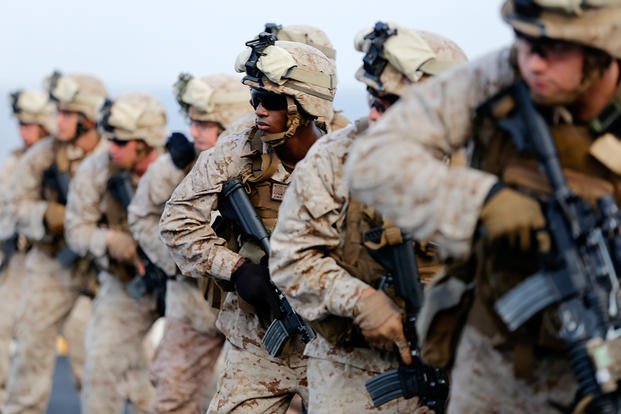By Gina Harkins

Small units -- including infantry squads -- need to be led by a staff sergeant, Commandant Gen. David Berger wrote in a new update to his 10-year force design plan. Putting staff noncommissioned officers in those roles will be a big cultural change for the service, which pushes leadership and decision-making far down the chain of command.
Marine leaders "will develop options for improving and sustaining the quality, maturity, and experience of small unit leader tactical skills and decision-making along with a pathway toward ensuring each squad or small unit within the infantry and reconnaissance communities is led by a Staff Sergeant," Berger wrote.
Corporals and sergeants currently lead infantry squads. The change is one of many facing the Marine Corps as the service reorganizes for a possible fight with China.
"You can't accelerate experience and maturity," Lt. Gen. Eric Smith, deputy commandant for Combat Development and Integration, said last week. "... If we're going to be operating in a disaggregated environment where you have 75 Marines throughout the first island chain -- at times under duress, in competition and in crisis -- you need that really seasoned, mature decision-making capability.
"There is an age component to that."
Marines' responsibilities are changing quickly as the military emerges from decades of fighting insurgents in the desert to gearing up to face off against Chinese or Russian forces. Marines will be operating in small teams, largely independently. They’ll be using high-tech unmanned technology and will be responsible for defending, from land, Navy ships’ ability to maneuver at sea.
Instead of a Marine firing a precision-guided artillery round to hit a target 25 miles away, "now you're shooting a naval-strike missile out in excess of 100 miles," Smith said.
"You want somebody who has done that a couple of times," he said.
At least two other commandants have suggested the Marine Corps would need more seasoned staff NCOs in leadership positions as warfare becomes more complex. Then-Commandant Gen. Joe Dunford told members of Congress in 2015 that he didn't think a largely first-term force would work for the wars ahead.
"Today, we may have a 60% first-term force, but I don't believe that it should be that case in the future," Dunford said.
Two years later, when Gen. Robert Neller was commandant, the Marine Corps was examining a plan to put staff sergeants in infantry squad leader billets, rather than corporals and sergeants.
To get that kind of force, though, the Marine Corps will need to pay. Lance corporals at the E-3 rank pocket about $2,300 a month, while a staff sergeant in the E-6 paygrade takes home roughly $3,300. To make up the difference, the Marine Corps is planning to drop 10,000 personnel by 2030 to reach an end strength of about 174,000.
A quarter of first-term Marines currently reenlist each year. That means, on average, about 20,000 junior Marines leave the Corps annually, said Maj. Joshua Benson, a spokesman for Combat Development and Integration.
Smith said giving more Marines the option to stay will likely be welcome news for many.
"The problem you have as a commander is telling them, 'Sorry you have to go home,' because we have too many that want to stay for the current model," he said.
Now as the Marine Corps shrinks in size while holding onto more personnel, recruiting requirements will also change. The Marine Corps currently adds about 30,000 new enlistees a year. That's going to drop in the years ahead, Smith said.
"What it says to those potential recruits that are in high school right now is, 'You're going to want to bring your A game. You're going to want to make sure that you are the most qualified,'" the general said. "If you wish to join the Marine Corps that's doing these kinds of difficult, challenging tasks inside of the engagement zone ... it's a competition. And I hope everybody's ready to compete."
The changes will also affect who the Marine Corps is recruiting. Maj. Gen. Jason Bohm, the head of Marine Corps Recruiting Command, told Military.com in December that Berger's plan for the service means more emphasis on cyber and information missions, electronic warfare and unmanned systems.
"What we're looking for is people that have a lot of self-discipline, self-confidence -- who are flexible, adaptable problem-solvers," Bohm said. Prospective Marines need to thrive in complex environments where they could lose communication with their commanders.
"We're focused on continuing to find that smart elite warrior," he added.
Smith stressed that Marine brass aren't saying every leadership position a sergeant fills now will become a gunnery sergeant billet. With the right training and through experimentation, they may find that lower-ranking Marines can qualify for the roles.
As a largely young force, the Marine Corps puts a great deal of leadership responsibility on its NCOs. Corporals and sergeants made strategic decisions in Iraq and Afghanistan, and even if there are fewer of them, Smith said he doesn't see that aspect of the service's culture and leadership changing.
The Marine Corps' future warfighting strategy centers around expeditionary advanced base operations, a concept that could spread a small team of 75 across an island in the Pacific, where they'll be tasked with defending sea and airspace from ashore to ensure Navy ships can move freely.
In that type of challenging environment, Smith said, "There's always going to be a [private first class] who's told, 'Hey, I need to step up and act like a lance corporal.' There's always going to be a corporal being told, 'I need you to step up and fill a sergeant's billet.'
"I don't fear [losing] that at all," he added.
-- Gina Harkins can be reached at gina.harkins@military.com. Follow her on Twitter @ginaaharkins.
No comments:
Post a Comment